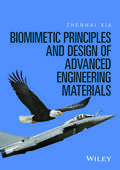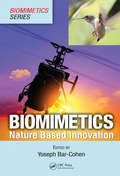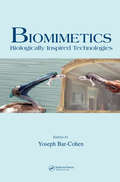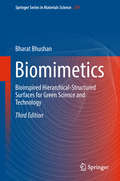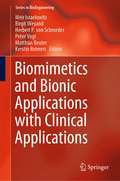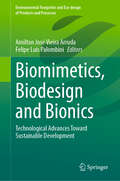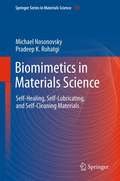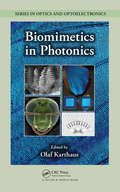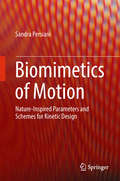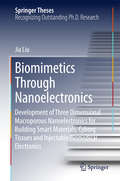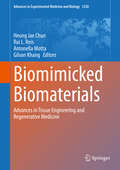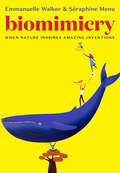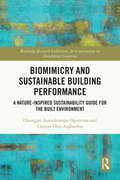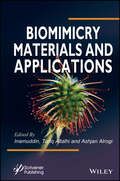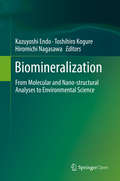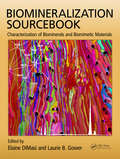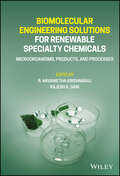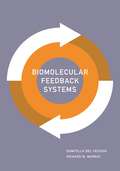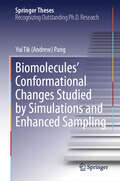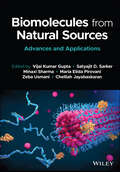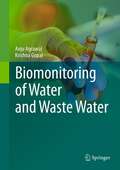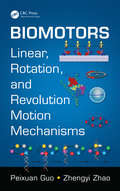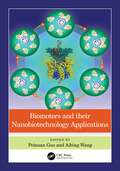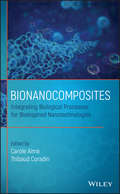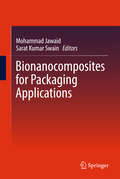- Table View
- List View
Biomimetic Principles and Design of Advanced Engineering Materials
by Zhenhai XiaThis book explores the structure-property-process relationship of biomaterials from engineering and biomedical perspectives, and the potential of bio-inspired materials and their applications. A large variety of natural materials with outstanding physical and mechanical properties have appeared in the course of evolution. From a bio-inspired viewpoint, materials design requires a novel and highly cross disciplinary approach. Considerable benefits can be gained by providing an integrated approach using bio-inspiration with materials science and engineering. The book is divided into three parts; Part One focuses on mechanical aspects, dealing with conventional material properties: strength, toughness, hardness, wear resistance, impact resistance, self-healing, adhesion, and adaptation and morphing. Part Two focuses on functional materials with unique capabilities, such as self-cleaning, stimuli-response, structural color, anti-reflective materials, catalytic materials for clean energy conversion and storage, and other related topics. Part Three describes how to mimic natural materials processes to synthesize materials with low cost, efficient and environmentally friendly approaches.For each chapter, the approach is to describe situations in nature first and then biomimetic materials, fulfilling the need for an interdisciplinary approach which overlaps both engineering and materials science.
Biomimetics: Nature-Based Innovation (Biomimetics Series)
by Yoseph Bar-CohenMimicking nature - from science fiction to engineering realityHumans have always looked to nature's inventions as a source of inspiration. The observation of flying birds and insects leads to innovations in aeronautics. Collision avoidance sensors mimic the whiskers of rodents. Optimization algorithms are based on survival of the fittest, the seed-
Biomimetics: Biologically Inspired Technologies
by Yoseph Bar-CohenNature is the world's foremost designer. With billions of years of experience and boasting the most extensive laboratory available, it conducts research in every branch of engineering and science. Nature's designs and capabilities have always inspired technology, from the use of tongs and tweezers to genetic algorithms and autonomous legged robots.
Biomimetics: Bioinspired Hierarchical-Structured Surfaces for Green Science and Technology (Biological and Medical Physics, Biomedical Engineering)
by Bharat BhushanThis book presents an overview of the general field of biomimetics - lessons from nature. It presents various examples of biomimetics, including roughness-induced superomniphobic surfaces which provide functionality of commercial interest. The major focus in the book is on lotus effect, rose petal effect, shark skin effect, and gecko adhesion. For each example, the book first presents characterization of an object to understand how a natural object provides functionality, followed by modeling and then fabrication of structures in the lab using nature’s route to verify one’s understanding of nature and provide guidance for development of optimum structures. Once it is understood how nature does it, examples of fabrication of optimum structures using smart materials and fabrication techniques, are presented. Examples of nature inspired objects are also presented throughout.
Biomimetics and Bionic Applications with Clinical Applications (Series in BioEngineering)
by Meir Israelowitz Birgit Weyand Herbert P. von Schroeder Peter Vogt Matthias Reuter Kerstin ReimersThis book presents current trends and developments in the rapidly growing field of biomimetics. It takes an application-oriented approach to reflect the interdisciplinary nature of this field: Experts, from academic as well as professional backgrounds, contribute to this book by describing and presenting state-of-the-art experiments and practical developments. A strong emphasis is put on the various possibility to apply biomimetics in tissue engineering, regenerative surgery, neurosurgery for clinical applications.
Biomimetics, Biodesign and Bionics: Technological Advances Toward Sustainable Development (Environmental Footprints and Eco-design of Products and Processes)
by Felipe Luis Palombini Amilton José Vieira ArrudaNature is a vast source of inspiration and information for the resolution of complex problems and can influence many varieties of design. Biomimetics, biodesign and bionics are three branches of interdisciplinary research merging biological and applied sciences. This volume collects cases that highlight recent breakthroughs in these disciplines. Biological features such as patterns, shapes, mechanisms, colors, structures, and more can be analyzed, organized, and modeled for application in human creations. Therefore, design, engineering, and architecture projects can benefit from solutions that were already tested and verified through evolution in the natural world. With the development of new technologies for the investigation, simulation, and testing of natural features, the path from nature to product can be accelerated. The cases presented in this work showcase how technological advancements are leading to improved design solutions and influencing our very comprehension of natureand its complex organization.
Biomimetics in Materials Science: Self-Healing, Self-Lubricating, and Self-Cleaning Materials (Springer Series in Materials Science #152)
by Michael Nosonovsky Pradeep K. RohatgiBiomimetics in Materials Science provides a comprehensive theoretical and practical review of biomimetic materials with self-healing, self-lubricating and self-cleaning properties. These three topics are closely related and constitute rapidly developing areas of study. The field of self-healing materials requires a new conceptual understanding of this biomimetic technology, which is in contrast to traditional engineering processes such as wear and fatigue. Biomimetics in Materials Science is the first monograph to be devoted to these materials. A new theoretical framework for these processes is presented based on the concept of multi-scale structure of entropy and non-equilibrium thermodynamics, together with a detailed review of the available technology. The latter includes experimental, modeling, and simulation results obtained on self-healing/lubricating/cleaning materials since their emergence in the past decade.
Biomimetics in Photonics (Series in Optics and Optoelectronics)
by Olaf KarthausBiomimetic photonics is a burgeoning field. Biologists are finding and describing a whole menagerie of unique and astonishingly complex nano- and microstructures in fauna and flora. Material scientists are developing novel multifunctional and hierarchical structures with a wide variety of post-nano era photonics applications. Mathematicians and com
Biomimetics of Motion: Nature-Inspired Parameters and Schemes for Kinetic Design
by Sandra PersianiThis book provides readers with a timely guide to the application of biomimetic principles in architecture and engineering design, and describes various aspects of motion in living systems. Geometric, mechanical and rhythmic parameters are listed and illustrated using examples from flora and fauna, and contextualized within an integrated mapping of biomechanical combinations that have proved their success in the course of evolution. For designers, the schemes identify those aspects that have a high probability of being efficiently combined, paving the way for new solutions and offering a method of evolutionary problem solving. The book guides readers through the field of nature-inspired design, offering an extraordinary resource for professional architects, engineers and designers, as well as for researchers and students. Throughout the book, natural evolution is approached as a powerful resource that can enrich architecture and design by providing innovative, optimal and sustainable solutions.
Biomimetics Through Nanoelectronics: Development of Three Dimensional Macroporous Nanoelectronics for Building Smart Materials, Cyborg Tissues and Injectable Biomedical Electronics (Springer Theses)
by Jia LiuThis thesis presents original research on how to seamlessly integrate electronics with living biological systems. Jia Liu has used silicon nanowires as active sensors to investigate biological signals at the cellular level. He has also designed nanoelectronic networks into flexible, three-dimensional (3D) and macroporous architectures, which mimic the structure of tissue scaffolds for in vitro 3D integrations with synthetic tissues and in vivo implantation by means of syringe injection. Importantly, the results demonstrate 3D interpenetrations of nanoelectronic networks with neural networks, 3D mapping of tissue activity and long-term implantation with minimal immunoresponses. Further, the book discusses potential applications for pharmacological studies, brain activity mapping and nanoelectronics enabled therapies. The findings presented here have gained wide recognition, including a top research ranking by Chemical & Engineering News and being listed among Scientific American's 10 world changing ideas in 2015.
Biomimicked Biomaterials: Advances in Tissue Engineering and Regenerative Medicine (Advances in Experimental Medicine and Biology #1250)
by Heung Jae Chun Rui L. Reis Antonella Motta Gilson KhangThis book is the second of two volumes that together offer a comprehensive account of cutting-edge advances in the development of biomaterials for use within tissue engineering and regenerative medicine. In this volume, which is devoted to biomimetic biomaterials, the opening section discusses bone regeneration by means of duck’s feet-derived collagen scaffold and the use of decellularized extracellular matrices. The role of various novel biomimetic hydrogels in regenerative medicine is then considered in detail. The third section focuses on the control of stem cell fate by biomimetic biomaterials, covering exosome-integrated biomaterials for bone regeneration, cellular responses to materials for biomedical engineering, and the regulation of stem cell functions by micropatterned structures. Finally, the use of nano-intelligent biocomposites in regenerative medicine is addressed, with discussion of, for example, recent advances in biphasic calcium phosphate bioceramics and blood-contacting polymeric biomaterials. The authors are recognized experts in the interdisciplinary field of regenerative medicine and the book will be of value for all with an interest in regenerative medicine based on biomaterials.
Biomimicry: When Nature Inspires Amazing Inventions
by Seraphine MenuNature did it first! A beautiful and whimsically illustrated explanation of cool inventions like Velcro and scuba suits that were inspired by the natural worldDiscover how bats led to the development of radar, whales inspired the pacemaker, and the lotus flower may help us produce indestructible clothing. "Biomimicry" comes from the Greek "bio" (life) and "mimesis" (imitation)." Here are various and amazing ways that nature inspires us to create cool inventions in science and medicine, clothing design, and architecture. From the fireflies that showed inventors how LEDs could give off more light to the burdock plant that inspired velcro to the high speed trains of Japan that take the form of a kingfisher's sleek, aerodynamic head, there are innumerable ways that we can create smarter, better, safer inventions by observing the natural world. Author Seraphine Menu and illustrator Emmanuelle Walker also gently explain that our extraordinary, diverse, and awe-inspiring world is like a carefully calibrated machine and its fragile balance must be treated with extreme care and respect. "Go outside," they say, "observe, compare, and maybe some day you'll be the next person to be struck by a great idea."
Biomimicry and Sustainable Building Performance: A Nature-inspired Sustainability Guide for the Built Environment (Routledge Research Collections for Construction in Developing Countries)
by Olusegun Aanuoluwapo Oguntona Clinton Ohis AigbavboaThis book on biomimicry assessment tools studies the concepts of sustainability, sustainable construction practices, and the evaluation categories that constitute a sustainability assessment tool. By exploring and drawing lessons from biomimicry principles, the book provides a nature-inspired assessment tool to aid and guide the sustainable transformation of the built environment. The book encapsulates the attributes of the conceptualised biomimicry assessment tool, which is aimed at helping practitioners, regulatory bodies, and governmental and non-governmental agencies in greening the built environment. Owing to the dire need for country-specific and tailor-made tools that address developing countries' needs, this book serves as a practical reference and theoretical springboard for the development of sustainability assessment tools for the built environment. Furthermore, the book serves as a guide in navigating the path towards achieving the greening agendas of the built environment and other sectors and seeks to align the new biomimicry assessment tool with the UN Sustainable Development Goals (SDGs). It is important reading for academics, professionals and advanced students in the built environment, engineering, and sustainable development.
Biomimicry Materials and Applications
by Inamuddin Tariq Altalhi Ashjan AlrogiBIOMIMICRY MATERIALS AND APPLICATIONS Since the concept of biomimetics was first developed in 1950, the practical applications of biomimetic materials have created a revolution from biotechnology to medicine and most industrial domains, and are the future of commercial work in nearly all fields. Biomimetic materials are basically synthetic materials or man-made materials which can mimic or copy the properties of natural materials. Scientists have created a revolution by mimicking natural polymers through semi-synthetic or fully synthetic methods. There are different methods to mimic a material, such as copying form and shape, copying the process, and finally mimicking at an ecosystem level. This book comprises a detailed description of the materials used to synthesize and form biomimetic materials. It describes the materials in a way that will be far more convenient and easier to understand. The editors have compiled the book so that it can be used in all areas of research, and it shows the properties, preparations, and applications of biomimetic materials currently being used. Readers of this volume will find that: It introduces the synthesis and formation of biomimetic materials; Provides a thorough overview of many industrial applications, such as textiles, management of plant disease detection, and various applications of electroactive polymers; Presents ideas on sustainability and how biomimicry fits within that arena; Deliberates the importance of biomimicry in novel materials. Audience This is a useful guide for engineers, researchers, and students who work on the synthesis, properties, and applications of existing biomimetic materials in academia and industrial settings.
Biomineralization: From Molecular and Nano-structural Analyses to Environmental Science
by Hiromichi Nagasawa Toshihiro Kogure Kazuyoshi EndoThis open access book is the proceedings of the 14th International Symposium on Biomineralization (BIOMIN XIV) held in 2017 at Tsukuba. Over the past 45 years, biomineralization research has unveiled details of the characteristics of the nano-structure of various biominerals; the formation mechanism of this nano-structure, including the initial stage of crystallization; and the function of organic matrices in biominerals, and this knowledge has been applied to dental, medical, pharmaceutical, materials, agricultural and environmental sciences and paleontology. As such, biomineralization is an important interdisciplinary research area, and further advances are expected in both fundamental and applied research.
Biomineralization Sourcebook: Characterization of Biominerals and Biomimetic Materials
by Elaine DiMasi Laurie B. GowerWhat does it mean to be at the forefront of a characterization technique? Novel implementation and research, finding new ways to visualize composites, and new techniques all play a role. Yet with the myriad of advances in the field, keeping up with new and advanced techniques, often from many different areas, has become a challenge. Biomineralizati
Biomolecular Engineering Solutions for Renewable Specialty Chemicals: Microorganisms, Products, and Processes
by R. Navanietha Krishnaraj Rajesh K. SaniDiscover biomolecular engineering technologies for the production of biofuels, pharmaceuticals, organic and amino acids, vitamins, biopolymers, surfactants, detergents, and enzymes In Biomolecular Engineering Solutions for Renewable Specialty Chemicals, distinguished researchers and editors Drs. R. Navanietha Krishnaraj and Rajesh K. Sani deliver a collection of insightful resources on advanced technologies in the synthesis and purification of value-added compounds. Readers will discover new technologies that assist in the commercialization of the production of value-added products. The editors also include resources that offer strategies for overcoming current limitations in biochemical synthesis, including purification. The articles within cover topics like the rewiring of anaerobic microbial processes for methane and hythane production, the extremophilic bioprocessing of wastes to biofuels, reverse methanogenesis of methane to biopolymers and value-added products, and more. The book presents advanced concepts and biomolecular engineering technologies for the production of high-value, low-volume products, like therapeutic molecules, and describes methods for improving microbes and enzymes using protein engineering, metabolic engineering, and systems biology approaches for converting wastes. Readers will also discover: A thorough introduction to engineered microorganisms for the production of biocommodities and microbial production of vanillin from ferulic acid Explorations of antibiotic trends in microbial therapy, including current approaches and future prospects, as well as fermentation strategies in the food and beverage industry Practical discussions of bioactive oligosaccharides, including their production, characterization, and applications In-depth treatments of biopolymers, including a retrospective analysis in the facets of biomedical engineering Perfect for researchers and practicing professionals in the areas of environmental and industrial biotechnology, biomedicine, and the biological sciences, Biomolecular Engineering Solutions for Renewable Specialty Chemicals is also an invaluable resource for students taking courses involving biorefineries, biovalorization, industrial biotechnology, and environmental biotechnology.
Biomolecular Feedback Systems
by Domitilla Del Vecchio Richard MurrayThis book provides an accessible introduction to the principles and tools for modeling, analyzing, and synthesizing biomolecular systems. It begins with modeling tools such as reaction-rate equations, reduced-order models, stochastic models, and specific models of important core processes. It then describes in detail the control and dynamical systems tools used to analyze these models. These include tools for analyzing stability of equilibria, limit cycles, robustness, and parameter uncertainty. Modeling and analysis techniques are then applied to design examples from both natural systems and synthetic biomolecular circuits. In addition, this comprehensive book addresses the problem of modular composition of synthetic circuits, the tools for analyzing the extent of modularity, and the design techniques for ensuring modular behavior. It also looks at design trade-offs, focusing on perturbations due to noise and competition for shared cellular resources.Featuring numerous exercises and illustrations throughout, Biomolecular Feedback Systems is the ideal textbook for advanced undergraduates and graduate students. For researchers, it can also serve as a self-contained reference on the feedback control techniques that can be applied to biomolecular systems.Provides a user-friendly introduction to essential concepts, tools, and applicationsCovers the most commonly used modeling methodsAddresses the modular design problem for biomolecular systemsUses design examples from both natural systems and synthetic circuitsSolutions manual (available only to professors at press.princeton.edu)An online illustration package is available to professors at press.princeton.edu
Biomolecules' Conformational Changes Studied by Simulations and Enhanced Sampling (Springer Theses)
by Yui Tik PangThis thesis illuminates the critical roles biomolecules, from small molecules to proteins, play in cellular functionality, particularly highlighting their conformational changes in response to environmental cues or binding events—a cornerstone concept in drug design as well as the manifestations of disease. It explores the conformational flexibility of small molecules and proteins, essential for predicting drug interactions and understanding biological processes. Through advanced molecular dynamics simulations and enhanced sampling techniques, this research offers unprecedented insights into the structural dynamics of three distinct biomolecular systems: the capsid assembly modulator AT130, the passenger domain of pertactin, and the SARS-CoV-2 spike protein. Each system represents a unique facet of biological complexity, underscoring the thesis's contribution to our understanding of biomolecular behavior across various scales. Furthermore, the thesis advances the field by updating the Force Field Toolkit for improved simulation accuracy. This work not only showcases the adaptability and importance of simulation techniques in modern biological research but also paves the way for novel therapeutic strategies by deepening our understanding of biomolecular dynamics.
Biomolecules from Natural Sources: Advances and Applications
by Vijai Kumar Gupta Satyajit D. Sarker Minaxi Sharma María Elida Pirovani Zeba Usmani Chelliah JayabaskaranBiomolecules from Natural Sources An up-to-date exploration of new and novel biomolecules In Biomolecules from Natural Sources: Advances and Applications, a team of accomplished researchers delivers up-to-date information on various bioresources, bioprocessing, production, mechanisms of action for selective bioactivity, biochemistry, targeted therapeutic roles and the advancements made on their bioactive potentials of new and novel biomolecules. The book presents recent trends in new and novel biomolecules and their identification, characterization, and potential applications. The selected contributions canvas a variety of breakthroughs in the understanding and applications of naturally derived biomolecules. Biomolecules from Natural Sources: Advances and Applications is an exhaustive collection of research and information, as well as an insightful and interdisciplinary treatment of a rapidly developing field. Readers will also find: A thorough introduction to phenolics from natural sources and plant-based natural artemisinin and its biomedical applications Comprehensive explorations of protein structure, function, and specificity and the pharmacological potential of pigments Practical discussions of biomolecules obtained through food biotechnology and the biological activities of natural glycosides In-depth examinations of biomolecules from basil and their pharmacological significance Perfect for biotechnologists, food technologists, and plant biologists, Biomolecules from Natural Sources: Advances and Applications will also earn a place in the libraries of bioprocessing engineers, as well as undergraduate and postgraduate students of biochemistry.
Biomonitoring of Water and Waste Water
by Krishna Gopal Anju AgrawalBiomonitoring of water quality is very much essential for assessing the overall health of water bodies and safe supply of drinking water. The chemical nature of toxicant is highly dynamic in environment with time and space whereas biological system can integrate all environmental variables over a large period of time in terms of effect that can be easily measured and quantified. In view of the above, there is a pressing need to determine the water quality of natural resources as well as drinking water based on the standard protocols and guidelines from regulatory agencies. It is clear that the synthetic chemicals are essential for our society to maintain the health and well being of the people. However, there has been a range of detrimental effects on human health and natural environment. In general, we need to improve our management of waste chemicals discharged into the air, water and soil environments. New techniques are needed to predict adverse effects before they occur and for the treatment of wastes. In addition, a range of social, political and economic factors will be needed to be taken into account in order to achieve success.
Biomotors: Linear, Rotation, and Revolution Motion Mechanisms
by Peixuan Guo and Zhengyi ZhaoThis book provides a comprehensive overview of biomotors (molecular motors) within the body with a specific concentration on revolving molecular motors. The bioengineering of these new revolving molecular motors will go a long way in creating machines that will be able to carry RNA and DNA drugs directly to diseased cells to destroy them. The book goes into specific details regarding the bioengineering, fabrication, synthesis, and future utilization of these devices for nanomedicine.
Biomotors and their Nanobiotechnology Applications
by Peixuan GuoThis book – a collection of reviews and research articles by the top academics in the field – provides a glimpse of the cutting-edge technology and research being carried out and shows how researchers are utilizing this knowledge to develop new areas of study and novel applications. It serves as a valuable resource while exploring the latest advances in virus particle assembly and demonstrating how the knowledge of fundamental processes has been used to advance bio-nanotechnology. Chapters detail biophysical approaches and biomotor research, discus the latest advances in DNA/RNA nanoparticle assembly and use, and introduce the use of DNA/RNA nanoparticles for drug delivery.
Bionanocomposites: Integrating Biological Processes for Bioinspired Nanotechnologies
by Carole Aimé Thibaud CoradinBeginning with a general overview of nanocomposites, Bionanocomposites: Integrating Biological Processes for Bio-inspired Nanotechnologies details the systems available in nature (nucleic acids, proteins, carbohydrates, lipids) that can be integrated within suitable inorganic matrices for specific applications. Describing the relationship between architecture, hierarchy and function, this book aims at pointing out how bio-systems can be key components of nanocomposites. The text then reviews the design principles, structures, functions and applications of bionanocomposites. It also includes a section presenting related technical methods to help readers identify and understand the most widely used analytical tools such as mass spectrometry, calorimetry, and impedance spectroscopy, among others.
Bionanocomposites for Packaging Applications
by Mohammad Jawaid Sarat Kumar SwainThis book presents a unified overview of eco-friendly bionanocomposites on the basis of characterization, design, manufacture, and application. It also explores replacing conventional materials with bionanocomposites with a focus on their use in packaging applications. In addition, the book broadens readers' insights by providing illustrations and tables summarizing the latest research on the packaging applications of different bionanocomposites. By offering a detailed account of this field of research and describing real-world applications, it enables researchers, scientists, and professionals in industry to develop a more informed understanding of the need for bionanocomposites in the development of green, biodegradable, and sustainable packaging applications.
